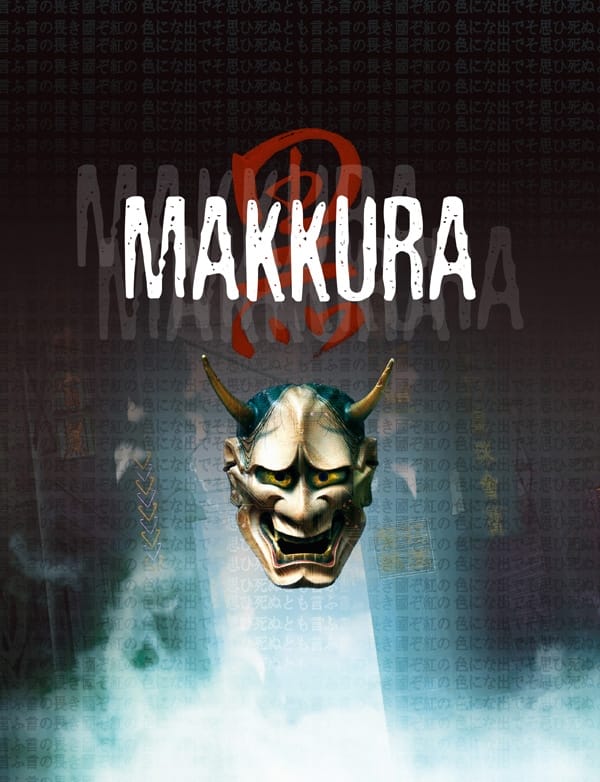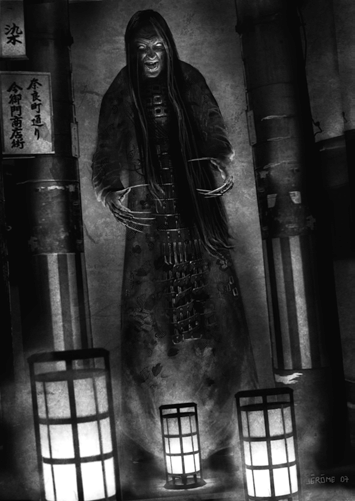
Download Makkura @ DriveThruRPG
I rather like Cubicle 7’s Japanese horror RPG Kuro. The game works well because it is nicely balanced mechanically, creates a thrilling if rather gritty noir cyberpunk world and layers in the supernatural.
It is entirely up to the GM and, of course, the actions or inactions of the players as to whether the game gets into the supernatural. It is possible to play Kuro just as a carefully researched Japanese flavoured cyberpunk. Imagine doing that for a year before your players start to realise that maybe something else, something unnatural, is pulling strings.
I pretty much pounced on Kuro – Makkura when it was released at the start of the month. This is the first supplement for the near-future RPG.
Makkura takes the PCs from not knowing about the supernatural threat in this alternative Japan right up and into the heart of the problem.
They lied to us.
They said it would all be over in a few weeks: the blockade, the food shortages, the power cuts.
It’s been over six months.
They said everything would be all right, but I can only see things getting worse, and there is something out there in the darkness. It’s getting harder to deny, and even harder to ignore.
I don’t know what to do. There is nowhere to run, nowhere to hide. The shadows are hungry and I can see them everywhere. They whisper that I am a Potential, that I have the power to make things right. But all I know is that when I stare into the darkness, something deep within is staring back.
As Makkura is an adventure you shouldn’t read this if you think you might be a player in the game later. There may be spoilers.
Actually, Makkura is a set of six interlinked full adventures. That’s nearly one for every day of the week. It’s a 131 page download.
The first catch to Makkura is that it may already be slightly spoiled.
The first adventure in the set takes up after the Origami adventure in the Kuro Core Rulebook. Now, it doesn’t matter if you’ve not run Origami yet because you can do so now. The risk is that players who’ve had the book and been told they’re not going to play through Origami may have read the adventure.
Makkura works best if Origami is a real surprise to the PCs. At the end of the first pre-written adventure, the one in the core rules, the PCs will have a list of “Potentials”. Your PCs need this list and need to be invested in it before Makkura comes to life.
The second catch to Makkura is that it rather relies on players concluding that something looks wrong, dangerous or out-of-order and therefore entirely proper to investigate. If you know your PCs are far more risk averse or prefer following their own in-game ambition then there is a very real risk you won’t be able to deploy any of the pre-written adventures.
The good news is that the adventures in Makkura link together like cleverly written episodes in a TV show that build up to an ever more dramatic plot arc and climax.
Here’s a super quick summary of the action in the book’s six adventures;
- Fugu – Players (hopefully) notice that a serial killer is using the list of Potentials (which their names appear on) to find targets.
- Mizuiro – Students are going missing, one has committed suicide and a popular ritual in which ghost stories are swapped may be involved. Oh yeah; the missing are all on the list of Potentials.
- Kujira – A whale washes up on Shin-Edo beach and its skull is oddly engraved with strange characters.
- Yukidomari – Drawn to a remote village, the PCs find a place plagued by bad weather, strange happenings and people vanishing.
- Tsukurigoto – Seven agents of dark appear to hunt down the Shi-Tenno and the keys they guard. Since the players have helped hide them they’ll be caught in the hunt.
- Kami – The finale. The thunder spirits must be stopped before they open the gates to Yomi.
The biggest takeaway from playing through, or even reading through, Makkura is that the big mystery even that sets up the wonderful Kuro setting is revealed. This whole RPG comes to live after the Panasiatic missile incident and the consequences from that. Makkura GMs know the secret. Makkura players will likely get a lot closer too it.
 The extra world detail and some new skill specialisations that the book offers mean that Makkura is something of an ultra-light sourcebook. The vast majority of the contents is spent on setting up the adventures, describing the related NPCs and events to the GM and making it as easy as possible to run the game.
The extra world detail and some new skill specialisations that the book offers mean that Makkura is something of an ultra-light sourcebook. The vast majority of the contents is spent on setting up the adventures, describing the related NPCs and events to the GM and making it as easy as possible to run the game.
Makkura does a pretty good job at helping the GM alone. You have all the stats you need and they’re where you’d expect them to be in the book. The actions or inactions of NPCs make sense. The locations are well described, easy to imagine and therefore easy to bring to life for players.
Perhaps the greatest success in Makkura is the pacing. The series of interlinked adventures does very well at “power touring” PCs from every day people to a closely linked group of ‘adventurers’ who have been through plenty of drama together, have grown incredibly and have a mutual investment. This also means that once GMs take their group through the Makkura elevator that they’ll have to take over with a fully fledged, aware and non-trivial supernatural group. Fortunately, the wonder of Kuro is that such a group will be a delight to write for. Unfortunately, it means powering through all the in-between layers in which the supernatural elements come creepily to life.
Overall? I’m a bit mixed on Makkura. It’s a great read. I think it’s very well structured. My concerns are that the players I know won’t go easily into it. If the first two adventures represent the front door to the world of Kuro Tensei then I think many gamers will naturally respond by avoiding it and looking around for an open window. I’d recommend the adventure for experienced GMs who know their group well.
Ultimately, Makkura does remind me while Kuro is such a great and sinister game.


